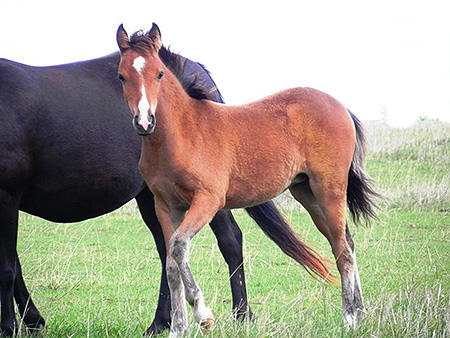
The aim is to investigate some of the gaps in knowledge of the selenium levels of broodmares and foals in Southern Ontario.
Guelph, ON June 19, 2024 - Selenium deficient soil can lead to several conditions in domestic animals including white muscle disease. Of importance to Ontario horse breeders is the fact that most foals are born with low blood selenium concentrations. Some clinical signs of low selenium levels may include dysphagia or weak suckle reflex due to pharyngeal/masticatory muscle weakness. Southern Ontario soil is known to be low in selenium.
Ontario Veterinary College researcher, Dr. Luis Arroyo, graduate student Isidora Rodriguez, and Dr. Alison Moore from OMAFRA, are currently involved in a study funded by the Ontario Animal Health Network-Equine. They aim to investigate some of the gaps in knowledge of the selenium levels of broodmares and foals in Southern Ontario.
Photo at Right: Study aims to fill in gaps in knowledge of the selenium levels of broodmares and foals in Southern Ontario. Photo Credit: Jolene Purdue
 Preliminary results have not undergone intensive analysis yet and clinical significance has not been established but, of the over 100 submissions so far, it seems most mares have adequate levels of selenium while most foals are below the reference values.
Preliminary results have not undergone intensive analysis yet and clinical significance has not been established but, of the over 100 submissions so far, it seems most mares have adequate levels of selenium while most foals are below the reference values.Selenium is an extremely important dietary element, and there are several other places with major soil deficiencies, like Netherlands and New Zealand. Reports describe an array of clinical conditions in cattle, for example, from retained fetal membranes, cystic ovaries, anoetrus, early and late embryo death, mastitis and increased somatic cell counts which are associated with selenium deficiency. Arroyo postulates, “We have not fully determined the extent of what these micronutrients can do if they are not at adequate levels.”
In the Ontario study, they will be looking at the current reference values in use and comparing them to the levels being reported in the study.
The Ontario Veterinary College (OVC) has seen clinical cases of rhabdomyolysis in foals. Muscle damage or white muscle disease is well known in calves, particularly fast-growing animals. Within a few months of life, they can develop muscular damage, including heart damage, which can be fatal.
Arroyo discusses some of the classical clinical signs of low selenium levels in a foal. They can exhibit trembling at the walk and milk coming out of the nose if they cannot swallow well. “There are also less overt clinical signs that we see in foals every year, when they come to the clinic at OVC,” explains Arroyo.
“They cannot nurse if they have pharyngeal collapse. We place a feeding tube and give support for a few days and supplement the selenium and then usually the foals are back to normal. So, there is a little bit of clinical evidence that perhaps these foals are having a milder form of selenium deficiency.”
This study will include a survey of the broodmare’s health status and geographical details. The researchers will look at all the mares and see which ones fall within adequate levels or levels below the reference values. They will be assessing if reference values and intra and inter assays variability.
“This will help determine accuracy of the tests and form the basis to design further studies,” says Arroyo “Studies that could compare factors such as horses diet, “hay versus grass pasture” or the effect of dietary supplementation with selenium versus not supplemented.” This could potentially lead to find conditions that can result from low levels of selenium and perhaps that help to make better informed interventions.
“Then there is the question of absorption,” says Arroyo. “Even when sufficient levels are present in the diet, this does not guarantee proper absorption or necessarily translate into adequate levels in blood.”
Nutrient absorption is highly impacted by the horse’s overall diet. For example, some nutrients can affect absorption of others (for example Copper and Molibdenum). Dr Arroyo states almost every foal in Ontario will get an injection of selenium and vitamin E right at birth to ensure they are receiving it systemically.
It is because foals receive this shot within the first day of foaling, that the samples for their study are to be collected prior to the injection to eliminate this external factor from influencing the research results.
It is because foals receive this shot within the first day of foaling, that the samples for their study are to be collected prior to the injection to eliminate this external factor from influencing the research results.
The researchers will be measuring the selenium and vitamin E levels in both the mares and foals, at time of birth, as well as the colostrum. Milk is known to be an insignificant source of selenium, but the study will measure how much may be available in milk regardless.
Stay tuned for the results of this important study which will aim to shed some light on the signs of low selenium in foals.
Stay tuned for the results of this important study which will aim to shed some light on the signs of low selenium in foals.
Ontario Animal Health Network has kindly provided funding for this initial study. Additional funding will be required to further investigate the preliminary findings and to determine additional factors such as the effects of different diets on selenium levels in horses.
Story by: Jackie Bellamy-Zions, Equine Guelph
About Equine Guelph:
Equine Guelph is the horse owners' and care givers' Centre at the University of Guelph in Canada. It is a unique partnership dedicated to the health and well-being of horses, supported and overseen by equine industry groups. Equine Guelph is the epicentre for academia, industry and government - for the good of the equine industry as a whole. For further information, visit www.equineguelph.ca.
Story by: Jackie Bellamy-Zions, Equine Guelph
About Equine Guelph:
Equine Guelph is the horse owners' and care givers' Centre at the University of Guelph in Canada. It is a unique partnership dedicated to the health and well-being of horses, supported and overseen by equine industry groups. Equine Guelph is the epicentre for academia, industry and government - for the good of the equine industry as a whole. For further information, visit www.equineguelph.ca.
Story web link: https://thehorseportal.ca/2024/05/study-to-examine-selenium-blood-concentration-in-ontario-broodmares-and-foals/
Source: University of Guelph


